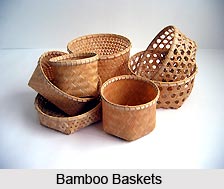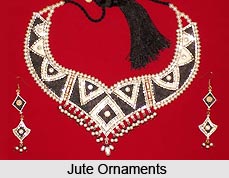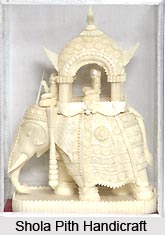 Handicrafts of Cooch Behar District are famed all over the country for their exquisite beauty and abundant variety. The tradition of making different handicrafts has emerged in the district ages ago. A number of artefacts are made with different materials like bamboo, cane, jute etc. These artefacts range from utilitarian to decorative purposes and are cherished throughout the country. Many of these items cater the household needs in rural areas.
Handicrafts of Cooch Behar District are famed all over the country for their exquisite beauty and abundant variety. The tradition of making different handicrafts has emerged in the district ages ago. A number of artefacts are made with different materials like bamboo, cane, jute etc. These artefacts range from utilitarian to decorative purposes and are cherished throughout the country. Many of these items cater the household needs in rural areas.
Sitalpati
Sitalpati is special kind of mat and is one of the most popular handicrafts of Cooch Behar district. The manufacture of this comparatively expensive mat is mainly centred at Barokodali, Nakkati-Pushnadanga and Ghughumari. Sitalpati refers to cool mats for which Mutra cane serves as the raw material. People belonging to Kayasth caste are traditionally involved in making this craft. Sitalpati is characterized by its fine texture, smoothness and glossiness. The mats have a unique feature of imparting coolness which suits warm and humid climate of West Bengal and is prevalent in rural areas. The popularity of these mats however has also spread in the urban areas owing to their utilitarian value and aesthetic appeal.
 Madur
Madur
Madur is another kind of mat, highly popular in the state. Madur Kathi reed growing in swampy areas serves as the raw material of these mats which are a common household item of West Bengal. Madur is decorated with beautiful geometrical and other motifs.
Bamboo and Cane Handicrafts
Cooch Behar is famous for bamboo and cane handicrafts. Before manufacturing different artefacts, cane is firstly thoroughly processed to make it insect resistant and waterproof. Dhamas and Chalunis, that are baskets and containers, are made out of bamboo and cane. These are extensively used in rural areas for carrying and storage of grains. Other artefacts of bamboo and cane are fruit-trays, bowls, paper-baskets, sofa-chairs, table-mats, magazine racks, waste paper baskets, decorative furniture and many more. Beautiful flower vases and lampshades are also made with bamboo.
Jute Handicrafts
Jute grows abundantly in the state of West Bengal. A number of exquisite articles are made out of this biodegradable product in Cooch Behar district. Folks of Rajbanshi and Polia tribes are traditionally engaged in this handicraft. A plethora of artefacts made out of jute comes in a variety of designs and sizes. Decorative jute bags, cushion covers, jute chappals, jute pen-stand, jute ornaments, jute mats and jute dolls are some of the common item furnished by this craftwork. Different training programs have also been launched by Government of India and World Crafts Council to train people with jute embroidery under Crafts Council of West Bengal. Fascinating and intricate embroideries on jute items are one of the most loved artefacts of the district.
 Kantha
Kantha
Kantha is another famous handicraft of Cooch Behar which is stitched by the women of rural areas. It is also known as thrift craft and comprise of layers of old clothes stitched by threads taken out of sari borders. Beautiful embroideries are rendered on them including scenes from daily folk life. Popular items of this handicraft are stoles, wall hangings, napkins, bedspreads, cushion covers, beach bags etc.
Shola Pith
Handicrafts of Shola pith, made in Cooch Behar, are also very famous in the country. Shola pith is a light pithy reed that grows in marshy lands. Special iron knives are used to carve out beautiful artefacts out of Shola pith. A number of objects are prepared with shoal pith such as models of temples, images of deities, marriage headgear, toys, garlands etc.
A number of skilled artisans have emerged over time who are adept in creating different types of articles. Tourists visiting this region have further popularized the Handicrafts of Cooch Behar. Government has also helped in the further development of handicraft industry in this district by providing training to the artisans.






